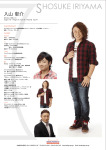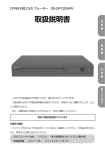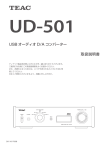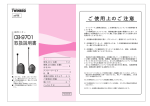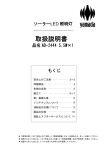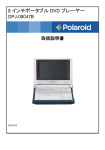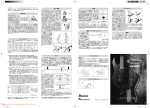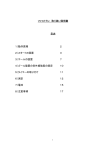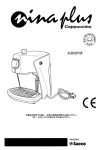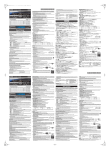Download 取扱説明書
Transcript
取扱説明書 このたびは、BOSS クロマチック・チューナー TU-15 をお買い上げいただきまして、まことにあ りがとうございます。 この機器 を正しくお使いい ただくために、ご使用 前に別紙「安全上のご 注意」と「使用上のご注 意」をよくお読みください。 また、この機器の優れた機能を十分ご理解いただくためにも、取扱説明書をよくお読みください。 取扱説明書は必要なときにすぐに見ることできるよう、手元に置いてください。 お買い上げ時、電池は接続されておりません。必ず「電池交換のしかた」にしたがって電池を接続 してください。 © 2002 ボス株式会社 本書の一部、もしくは全部を無断で複写・転載することを禁じます。 ■ 特長 ・ 暗闇でもチューニング可能な、メーター・バック・ライト搭載。 ・ 自動で音名/弦番 号を判別する「オート・モード」と、弦の張り替え時などに 便利な音名/弦 番号を指定する「マニュアル・モード」 。 ・ 半音階 12 全てを音名表示でチューニングできる「クロマチック・モード」と、ギター/ベー ス・ギターの弦番号表示でチューニングできる「ギター/ベース・モード」 。 ・ 7 弦ギター、6 弦ベース・ギター完全対応。 ・ 半音下げから 5 半音(2 音半)下げまで対応した、フラット・チューニング機能。 ・ DROP D, OPEN D/E/G/A, DADGAD チューニングを簡単にチューニングできるオープン・ チューニング機能。 ・ フレ ットを押さ えた音程を 正確に保つ ために必要 なオクター ブ調整を簡 単に行なえ る、オク ターブ調整モード。 ・ 基準音発音機能(サウンド・モード)搭載。 ・ チューニング完了を音で知らせるアキュピッチ機能。 ・ AC アダプターが使用できる AC アダプター・ジャック装備。 ・ 電池の消耗を防ぐ、オート・パワー・オフ機能(電池使用時のみ) 。 ■ 各部の名称 バック・ライト・スイッチ[LIGHT] バック・ライトのオン/オフ を切り替えます。 電源スイッチ[POWER] 電源のオン/オフを切り替えます。 電池動作時には、何も操作せずに約30分経過すると自動的 [CHROMATIC] ボタン [SOUND] に電源がオフになります(オート・パワー・オフ機能)。 ボタン [GUITAR/BASS] ボタン 再度電源オンにするときは、一度スイッチオフを[OFF]にし てからオン[ON]にします。 メーター&ディスプレイ スピーカー ACアダプター・ジャック ACアダプター(BOSS PSA-100:別売) を接続します。 0 +5 -50 0C アウトプット・ジャック インプット ジャックに接続された楽器の信号が出力されます。 また、電源スイッチをオフ[OFF]にすると、チューナー回路が完 全に分離され、音質変化なしに楽器の信号が出力されます。 EN N CE T インプット ジャック チューニングするギターやベース・ギター等 の楽器を接続します。 [PITCH] ボタン [AUTO/MANUAL] ボタン [NOTE] ボタン マイク アコースティック楽器をチューニングするとき使用します。 マイクをできる限り楽器に近づけてください。 マイクを使用するときはインプット・ジャック、アウトプット・ ジャックには何も接続しないでください。 ■ ディスプレイ [FLAT] ボタン [OPEN TUNING] ボタン [OCT ADJ] ボタン ■ チューニングのしかた フラット・チューニング表示 オート/マニュアル・モード表示 ギター/ベース・モード表示 音名/弦番号表示 クロマチック・モードのと きは「音名」+「オクター ブ」を、ギター/ベース・ モードのときは「弦番号」 +「音名」を表示します。 オクターブ調整モード表示 オクターブ調整モードのと きに「OCT ADJ」が点灯 します。 ■ チューニング完了を音で知らせる(アキュピッチ機能) 通常の OPEN D/E/G/A だけでなく、頻度の多い DROP D から D ADGAD までの 6 種類のオープ ン・チューニングを、弦番号でチューニングすることができます。 ギター/ベース・モードにしてから [OPEN TUNING] ボタンを押して、設定するチューニングの種 類を選びます。 安定して± 3 セントの範囲に入っていたら、 音でチューニング完了を知らせるアキュピッチ機能を 搭載しています。 チューニング完了の 音は、チューニングしている 音の高さに合わせて、C6 ∼ B 6 の範囲で「ピ ピッ」と鳴ります。 ※ 工場出荷時、アキュピッチ機能はオンになっています。 アキュピッチ機能のオン/オフを切り替えることができます。以下の操作を行うと、現在とは逆の 状態に設定されます。 ギター・モードのとき 種類 オープン・チューニング表示 通常(レギュラー) 表示無し 1. 電源スイッチをオフにします。 2. [SOUND] ボタンを押しながら電源スイッチをオンにします。 アキュピッチ機能のオン/オフが切り替わり、ディスプレイにオン/オフの状態が約 5 秒間表 示されます。 OPEN D OPEN E オープン・チューニング 表示 0 NT CE -50 +5 0C EN T 基準ピッチ表示 メーター 表示している音名、弦 番号に対するピッチの ズレを表示します。 電池残量警告表示 通常は消灯しています。 電池が減ってくると「 」 が点滅します。点滅したと きは、お早めに電池を交 換してください。 バック・ライト点灯表示 バック・ライトがオンのと き「 」が点灯します。 チューニング・ガイド チューニングの目安をインジケーターの点灯で表示します。 「 」点灯:ピッチが低い 「 」点灯:ピッチが高い 「 」と「 」が点灯:ピッチが合っている(±3セント) ■ オート/マニュアル・モードについて 通常は、自動で音名/弦番号を表示する「オート・モード」で使用します。 弦を張り替えたときやオープン・チューニング機能を使用するときは、弦番号/音名をあらかじめ [NOTE]ボタンで指定する「マニュアル・モード」が便利です。 [AUTO/MANUAL] ボタ ンを押 すた びにモ ード が切り 替わ り、ディス プレ イに“AUTO”または “MANU”が表示されます。 ■ クロマチック、ギター/ベース・モードについて モード 説明 操作 ディスプレイ クロマチック 半音毎 12 個全部の音程を チューニングできます。 [CHROMATIC] ボタンを 押します。 音 名とオクターブが 表示されます。 ギター “GUITAR”が点灯するよ “GUITAR ”が 点 灯 ギ ター の 弦番 号で チュ ー う に、[GUITAR/BASS] し、弦 番号と音名が ニングできます。 ボタンを数回押します。 表示されます。 ベース ベース・ギターの弦番号で チューニングできます。 “BASS”が点灯するよう “BASS”が 点 灯 し、 に、[GUITAR/BASS] ボ 弦 番号と音名が表示 タンを数回押します。 されます。 1. チューニングする楽器をインプット・ジャックに接続します。 アコースティック楽器のチューニングには内蔵マイクを使用しますので、インプット/アウト プット・ジャックには何も接続しないで、楽器の近くに TU-15 を置いてください。 ※ 他の機器と接続する ときは、誤動作やスピーカーなどの破損を防ぐため、必 ずすべての機器の 音量を絞った状態で電源を切ってください。 2. 電源スイッチを [ON] にします。 ディスプレイに基準ピッチが表示されます。 基準ピッチを変更するには、設定したい基準ピッチが表示されるまで [PITCH] ボタンを数回押 します。 (工場出荷時には 440 Hz に設定されています。 ) オート・パワー・オフ機能で電源がオフになっているときは、電源スイッチを一度 [OFF] にし てから [ON] にしてください。 3. オート・モードにします。 通常は自動的に音名/弦番号を表示する「オート・モード」で使用します。 ディスプレイに“MANU”が表示されているときは、[AUTO/MANUAL] ボタンを押して “AUTO” を表示させます。 4. 楽器を単音で鳴らします。 鳴らした音に近い音名/弦番号がディスプレイに表示されます。 正確な音程とのズレが、メーターとチューニング・ガイドで表示されます。 5. 楽器をチューニングします。 目的の音名/弦 番号がディスプレイに表示 され、チューニング・ガイドの“ ”と“ ”が両 方点灯し、メーターの針が 0(中央)を指すように楽器をチューニングします。 安定してピッチが合うと、 「ピピッ」と鳴ってチューニング完了を知らせます。 (アキュピッチ 機能) ■ フラット・チューニング 通常のチューニング(レギュラー・チューニング)より実際の音程を全体に下げた(半音から 5 半 音 =2 音半下げまで)チューニングを、通常の表示のまま簡単に行なうことができます。 [FLAT] ボタンを押して、表示している音名に対して実際の音を何半音下げるかを選びます。 ディスプレイのフラット表示が、表示無し(レギュラー), (半音下げ), ,.. (5 半音)に変 わります。 アキュピッチ機能 オン アキュピッチ機能 オフ 0 0 OPEN G OPEN A -50 DROP D +5 0 -50 +5 0 その後、通常の表示/動作になり、そのまま使用できます。 ※ アキュピッチ機能の設定は、電源をオフにしても記憶されています。 DADGAD ■ メモリー機能 ベース・モードのとき fig.01 T ■ オープン・チューニング 種類 オープン・チューニング表示 通常(レギュラー) 表示無し DROP D ■ 基準音を聞きながらチューニングする(サウンド・モード) 内蔵スピーカーから基準音を鳴らします。 クロマチック・モードのときは、半音ごと 12 個の基準音が鳴らせます。 ギター/ベース・モードのときは、開放弦の音程が鳴らせます。 1. あらかじめ、合わせたいチューニングの種類(クロマチック/ギター/ベース、フラット、オー プン・チューニングなど)を選んでおきます。 2. [SOUND] ボタンを押します。 3. 合わせたい音名 / 弦番号が表示されるように [NOTE] ボタンを押して選びます。 4. 基準音に合わせて、楽器をチューニングします。 5. 基準音の発音を止めるには [SOUND] ボタンを押します。 ■ オクターブ調整モード ギターのフレットを押さえた音程を正確に保つためには、オクターブ調整が必要です。 TU-15 には、開放弦と 12 フレットを押さえた音を交互に鳴らして、ブリッジを前後どちらにずら せば良いかを表示するオクターブ調整モードがあります。 簡単に手早く、オクターブ調整を行うことができます。 1. あらかじめギター/ベース・モードで楽器をチューニングしておきます。 2. [OCT ADJ] ボタンを押します。 ディスプレイの“OCT ADJ”が点灯してギターまたはベース・モードになります。 マニュアル・モードのときは [NOTE] ボタンで調整する弦を選びます。 3. 開放弦を弾きます。 安定してピッチがとれたら“OF”が点灯します。 電池を入れておくと、電源をオフにしても各種の設定を記憶させておくことができます。 記憶される設定内容は以下の項目です。 ・ 基準ピッチ ・ オート/マニュアル モード ・ マニュアル モードとサウンド・モードでの音名/弦番号 ・ クロマチック/ギター/ベース・モード ・ フラット・チューニングの設定 ・ オープン・チューニングの設定 ・ オート・パワー・オフの設定 ・ アキュピッチの設定 ■ 電池の交換のしかた 電池が消耗してくると、ディスプレイの電池残量警告表示が点滅します。 なるべく早く新しい電池と交換してください。 ※ 電池は電源オ フ時の記憶保持用電源としても使われています。電池 を本体から抜いたり、電池 が消耗 したときには、メモリ ー機能で記憶して いる各種設定は工 場出荷時の状態に 戻ります。 (AC アダプターが本体とコンセントに接続されている場合は各種設定は記憶されたままになり ます。 ) 1. 本体 底部の 電池ブタ を押し ながらス ライド させ て外します。 2. 古い電池を取り出します。 3. 新しい同じ種類の単 3 乾電池を 2 本入れます。 ※ 電池の極性(+ / −)を間違えないように注意し てください。 4. 電池ブタをスライドさせて確実に閉めます。 ※ 新しい 電池と一度使用し た電池や種類の違 う電池 を混 ぜて使用しないで ください。液漏れの 原因と なります。 + - メーター調整 ボリューム穴 4. 次に、同じ弦の 12 フレットを押さえて弾きます。 安定してピッチがとれたら “12 F”が点灯して、メーターがブリッジをずらす方向を指示します。 針が左側( 側)のときはブリッ ジをネック側に、右側( 側)のと きはブリッジをネックと 反対側に移動させます。 ※ ブリッジの移動のしかたは、ギターの取扱説明書をご覧ください。 ■ メーター針の調整 5. ブリッジを移動させたら、操作 3 ∼ 4 を繰り返します。 “12 F”が点灯しているときにメーターが 0(中央)を指せば、調整が完了です。 1. [PITCH] ボタンを押しながら、電源をオンにします。 メーターの針が 0 位置を指しているか確認します。 オクターブ調整モードを終了させま 6. 全ての弦の調整が終わったら [OCT ADJ] ボタンを押して、 す。 2. 針が 0 位置を指していないときは、[PITCH] ボタンを押したまま、小さな(-)ドライバー(精 密ドライバー 1.2 mm 程度)で調整ボリュームを回して、0 位置を指すようにします。 ■ 基準ピッチの変更 3. [PITCH] ボタンから指を離すと、通常の動作状態に戻ります。 ※ 調整するときは、小さな(-)ドライバー以外の工具を使用しないでください。また、無理な力 を加えないでください。故障の原因になります。 演奏時に基準の音程になる楽器(例えばピアノ)の A4(ピアノでは鍵盤中央のラの音)の周波数 を「基準ピッチ」といいます。 ■ 主な仕様 電源をオンにすると、現在の基準ピッチが表示されます。 [PITCH] ボタンを押すたびに、基準ピッチが 1 Hz ずつ変化します。 基準ピッチの変更可能な範囲は A=430 ∼ 449 Hz です。 ※ 工場出荷時は A=440 Hz になっています。 ■ 電池動作時の電池の消耗を防ぐ (オート・パワー・オフ機能) 電池動作時には、電源スイッチの切り忘れによる電池の消耗を防ぐオート・パワー・オフ機能が働 きます。 電源をオンにした後、最後のボタン操作またはチューニング音の入力が無くなってから約 30 分以 上経過すると、自動的に電源がオフになります。 オート・パ ワー・オフ機能で電源が オフになったとき に再度電源をオンに するには、一度電源ス イッチをオフにして、再度オンにしてください。 ※ 工場出荷時、オート・パワー・オフ機能はオンになっています。 オート・パワー・オフ機能のオン/オフを切り替えることができます。以下の操作を行うと、現在 とは逆の状態に設定されます。 1. 電源スイッチをオフにします。 2. [PITCH] ボタン、[AUTO/MANUAL] ボタン、[NOTE] ボタンを押しながら電源スイッチをオン にします。 オート・パワー・オフ機能のオン/オフが切り替わり、ディスプレイにオン/オフの状態が約 5 秒間表示されます。 オート・パワー・オフ機能 オン オート・パワー・オフ機能 オフ 0 -50 0 +5 0 経年変化や衝撃等でメーター針の 0 位置がずれた場合、 以下の操作でメーター針の調整を行なうこ とができます。 ※ 通常、0 位置がずれることはほとんどありません。針の 0 位置がずれているときだけ調整して ください。 -50 その後、通常の表示/動作になり、そのまま使用できます。 ※ オート・パワー・オフ機能の設定は、電源をオフにしても記憶されています。 +5 0 基準ピッチ: 測定範囲: 測定精度: 入力インピーダンス: インジケーター: 内蔵スピーカー: 接続端子: A4=430Hz-449Hz(1 Hz 単位) E0(20.6 Hz)∼ C8(4186.0 Hz) ± 1 セント 10 MΩ メーター、LCD ディスプレイ 直径 36 mm ダイナミック・タイプ インプット・ジャック、アウトプット・ジャック、 AC アダプター・ジャック 電源: 単 3 乾電池× 2;DC 3V または ACアダプター DC 9V (PSA-100:別売) 消費電流: 15mA(バックライト・オフ、基準音発音オフ) 、 55mA(バックライト・オン、基準音発音オン) 連続使用時の電池の寿命(マンガン電池使用時) : 約 45 時間(バックライト・オフ、基準音発音オフ、A4 連続入力) 、 約 15 時間(バックライト・オン、基準音発音オン) ※使用状態によって異なります 外形寸法: 149(幅)× 58(奥行)× 40(高さ)mm 質量: 190g(乾電池含む) 付属品: 単 3 型マンガン乾電池(R6 1.5 V)2 本、取扱説明書、 チラシ(安全上のご注意/使用上のご注意/保証書) 、サービスの窓口 別売品: AC アダプター(PSA-100) ※ 製品の仕様および外観は、改良のため予告なく変更することがあります。 ■ Open Tuning Owner’s Manual Thank you, and congratulations on your choice of the BOSS TU-15 Chromatic Tuner. Before using this unit, carefully read the sections entitled: “USING THE UNIT SAFELY” and “IMPORTANT NOTES” (separate sheet). These sections provide important information concerning the proper operation of the unit. Additionally, in order to feel assured that you have gained a good grasp of every feature provided by your new unit, this manual should be read in its entirety. The manual should be saved and kept on hand as a convenient reference. As shipped, the TU-15’s batteries are not yet installed. Be sure to read “Changing the Batteries” and then follow the instructions to install the batteries. Copyright © 2002 BOSS CORPORATION All rights reserved. No part of this publication may be reproduced in any form without the written permission of BOSS CORPORATION. ■ Features • Backlit meter allows tuning even in dark environments. • Also features an “AUTO mode,” which automatically determines the note name or string number, and a “MANUAL mode,” where you can specify note names and string numbers (which comes in handy after you’ve restrung your instrument). • Includes “CHROMATIC mode,” which permits tuning to any of the twelve semitone steps by note name over the entire chromatic scale, and a “GUITAR/BASS mode” for tuning to guitar and bass string numbers. • Compatible with seven-string guitars and six-string basses. • Includes a Flat Tuning function, which lowers all pitches from one semitone to five semitones (two and a half steps). You can tune by string number not only with normal OPEN D/E/G/A, but with six kinds of open tuning, from the often-used DROP D to DADGAD. After switching to GUITAR/BASS mode, press the [OPEN TUNING] button to select the type of tuning you want to set. In GUITAR Mode Type Open Tuning Indicator Regular Not Displayed OPEN D • Open Tuning function makes it easy to achieve DROP D, OPEN D/E/G/A, and DADGAD tunings. • OCTAVE ADJUST mode makes the octave adjustments required to maintain the correct pitch when playing the frets. • SOUND mode plays the reference tone. • Accu-Pitch function produces a beeping tone to signal that the tuning is correct. • AC adaptor jack for use with AC adaptor. • Auto Power Off function helps prevent battery drain (only when batteries are used). 2. Hold down the [SOUND] button and slide the POWER switch to ON. The Accu-Pitch setting is switched, and the current ON/OFF status is indicated in the display for approximately five seconds. OPEN G OPEN A Accu-Pitch Function ON Accu-Pitch Function OFF DROP D 0 0 DADGAD -50 In BASS Mode Power Switch [POWER] Switches the power on and off. Whenever the TU-15 has remained totally idle for approximately thirty minutes, while running on battery power, the power is automatically switched off. To turn the power back on, first slide the POWER switch to [OFF], then to [ON] again. Speaker AC Adaptor Jack Connect the AC adaptor (the optional BOSS PSA series) here. 0 NT +5 -50 OUTPUT Jack The signal of the instrument connected to the INPUT jack is output from this jack. The tuner’s circuitry is completely bypassed once you place the POWER switch at the OFF position, so your instrument’s signal is output without any change in the tone quality. 0C EN CE T INPUT Jack Connect the guitar, bass guitar, or other instrument to be tuned here. [PITCH] Button [AUTO/MANUAL] Button [NOTE] Button MIC Use this when tuning acoustic instruments. Position the mic as closely as possible to the instrument. Do not connect anything to the INPUT or OUTPUT jacks when using the mic. ■ Display ■ How to Use the Tuner FLAT TUNING Indicator AUTO/MANUAL Mode Indicator GUITAR/BASS Mode Indicator Note Name/String Number Indicator In CHROMATIC mode, this indicates the “note name” and “octave”; in GUITAR/BASS mode, it indicates the “string number” and “note name.” OCTAVE ADJUST Mode Indicator “OCT ADJ” lights up when the OCTAVE ADJUST mode is on. OPEN TUNING Indicator 0 N CE T -50 +5 0C EN T REFERENCE PITCH Indicator Meter This shows the difference in pitch from the indicated note name or string number. Batteries Low Warning Indicator “ ” is normally off, but flashes when the batteries begins to run low. Replace batteries promptly when you see this indicator flashing. Backlight Indicator “ ” lights when the backlight is on. Tuning Guide The tuning indicator lights to show how close you are to the target pitch. When “ ” lights: pitch is flat (low) When “ ” lights: pitch is sharp (high) When “ ” and “ ” light: in tune (±3 cents) ■ Note About AUTO and MANUAL Modes ■ Regarding CHROMATIC and GUITAR/BASS Modes Mode Description Operation 1. Connect the instrument to be tuned to the INPUT jack. The built-in mic is used for tuning acoustic instruments. When using the mic, make sure that nothing is connected to the INPUT or OUTPUT jacks, and place the TU-15 near the instrument. * To prevent malfunction and/or damage to speakers or other devices, always turn down the volume, and turn off the power on all devices before making any connections. 2. Slide the POWER switch to [ON]. The reference pitch is indicated in the display. To change the reference pitch, press the [PITCH] button one or more times until the pitch you want to set as the reference pitch appears in the display (the factory default setting is 440 Hz). If the power has been turned off by the Auto Power Off function, slide the POWER switch to [OFF], then to [ON] again. 3. Switch to AUTO mode. Normally, “AUTO mode” is used. In this mode, note names and string numbers are indicated automatically. If “MANU” appears in the display, press the [AUTO/MANUAL] button so that “AUTO” is shown. 4. Play a single note on the instrument. The note name/string number for the note that is playing appears in the display. The meter and Tuning Guide show how far the note is from the correct pitch. 5. Tune the instrument. With the intended note name/string number appearing in the display, tune the instrument so that both “ ” and “ ” of the Tuning Guide are lit, and the meter needle points to 0 (center position). When a stable pitch is achieved, the tuner makes a beeping sound, informing you that the tuning is completed (with the Accu-Pitch function). Normally, you will be using “AUTO mode,” in which note names and string numbers are indicated automatically. However, after restringing an instrument, or when using the Open Tuning function, it is more convenient to use “MANUAL mode,” in which you specify the note names and string numbers using the [NOTE] button in advance. Pressing the [AUTO/MANUAL] button toggles the mode between “AUTO” and “MANU.” The current mode is indicated in the display. Type Open Tuning Indicator Regular Not Displayed * ■ Flat Tuning This lowers the actual pitch of all notes below the regular tuning (from one to five semitones, or two and a half steps), and can be accomplished simply without changing the regular display. Press the [FLAT] button and select the number of semitones the actual pitch is to be lowered relative to the note appearing in the display. No flat symbols appear when regular tuning is selected; “ ” indicates the pitch is lower by one semitone, “ ” a whole tone, and so on, with “ ” marks indicating a drop of five semitones. The tone name and octave are displayed. GUITAR Press the [GUITAR/BASS] Allows tuning by guitar string button one or more times until number. “GUITAR” is lit. “GUITAR” lights up, and the string number and tone name are displayed. BASS Press the [GUITAR/BASS] Allows tuning by bass guitar button one or more times until string number. “BASS” is lit. “BASS” lights up, and the string number and tone name are displayed. 0 -50 +5 0 The Accu-Pitch setting remains stored even after the power is turned off. ■ Memory Functions ■ Tuning While Listening to the Reference Tone (SOUND Mode) The built-in speaker plays the reference tone. In CHROMATIC mode, you can play any of the twelve notes in the chromatic scale. In GUITAR/BASS mode, pitches corresponding to the open strings are played. 1. First select the type of tuning you want to use (e.g., Chromatic, Guitar, Bass, Flat, or Open Tuning). 2. Press the [SOUND] button. 3. Press the [NOTE] button to display the note name or string number you want to tune. Once batteries are installed in the TU-15, a number of different settings can be stored in memory, where they’ll be preserved even while the power is turned off. The settings stored in memory are listed below. • Reference Pitch • AUTO/MANUAL Mode • Note Names/String Numbers in MANUAL Mode and SOUND Mode • CHROMATIC/GUITAR/BASS Mode • Flat Tuning Settings • Open Tuning Settings • Auto Sound Off Setting • Accu-Pitch Setting 4. Tune the instrument to the reference tone. ■ Changing the Batteries 5. Press the [SOUND] button to stop playing the reference sound. A “batteries low” warning flashes in the display when the batteries begin to go dead. Replace the batteries as soon as possible. * The settings stored by the memory function are reset to the default factory settings if the batteries are removed from the tuner, or if the batteries get completely depleted. (However, the stored settings are preserved if the TU-15 remains connected to an electrical outlet with the AC adaptor.) ■ OCTAVE ADJUST Mode To ensure that the correct pitch is played when you press the strings against the guitar frets, Octave Adjust is required. The TU-15 features an OCTAVE ADJUST mode, which indicates whether you need to shift the bridge up or down when the sound of the open string and the sound with the string pressed at the twelfth fret are played. This function allows you to make octave adjustments quickly and easily. 1. First tune the instrument in GUITAR/BASS mode. 2. Press the [OCT ADJ] button. The “OCT ADJ” in the display lights up, and the tuner switches to GUITAR or BASS mode. In MANUAL mode, you can select the string to adjust by pressing the [NOTE] button. 3. Play an open string. When the pitch stabilizes, “OF” lights up. 4. Next, play the same string while holding it down at the twelfth fret. When a stable pitch is obtained, “12 F” lights up, and the meter indicates the direction in which the bridge should be shifted. If the needle moves to the left side (the side), shift the bridge toward the neck; if the needle moves to the right side (the side), shift the bridge away from the neck. * For instructions on moving the bridge, refer to the owner’s manual that came with your guitar. 5. After shifting the bridge, repeat Steps 3 and 4. This adjustment is complete when the meter is at 0 (center) while “12 F” is lit. 6. When you have finished adjusting all of the strings, press the [OCT ADJ] button to exit OCTAVE ADJUST mode. ■ Changing the Reference Pitch The frequency for A4 (Middle A on the piano) for an instrument (such as the piano) whose pitch other instruments are tuned to is called the “reference pitch.” The current reference pitch is indicated when you turn on the TU-15. The reference pitch changes by 1 Hz each time you press the [PITCH] button. You can adjust the reference pitch to any value from A=430 Hz to A=449 HZ. * The factory default setting is A=440 Hz. ■ Preventing Battery Drain When Running on Batteries (Auto Power Off Function) The TU-15 features an Auto Power Off function that helps prevent the batteries from going dead if you forget to switch off the unit when using battery power. After the TU-15 is turned on, if approximately thirty minutes passes without any button being pushed or a tuning sound being input, the power is then turned off automatically. To turn on the power after it has been turned off by the Auto Power Off function, first slide the POWER switch to OFF, then slide it to ON once more. * The Auto Power Off function is turned on at the factory. You can turn the Auto Power Off function on and off. Use the following procedure to switch the setting to the opposite of the current setting. 1. Turn the POWER switch to OFF. 2. Hold down the [PITCH] button, the [AUTO/MANUAL] button, and the [NOTE] button and slide the POWER switch to ON. The Auto Power Off setting is switched, and the current ON/OFF status is indicated in the display for approximately five seconds. Auto Power Off Function ON Auto Power Off Function OFF 0 0 -50 * +5 0 -50 1. Press down and slide off the lid of the batteries compartment (located on the bottom of the unit). 2. Remove the old batteries from the compartment. 3. Insert two of the same type of fresh AA batteries. * Make sure the “+” and “-” ends of the batteries are oriented correctly. + - Meter Adjustment Control 4. Slide the lid back into place. * Do not mix fresh batteries with used ones, or mix batteries of different types. Doing so can result in fluid leakage. ■ Calibrating the Meter’s Needle Over time, or as the result of being knocked around, the meter needle may drift away from the 0 position. If this occurs, you can recalibrate the needle using the following procedure. * Normally, the needle almost never goes off center. Adjust the needle only in the event that it has shifted from the 0 position. 1. Hold down the [PITCH] button and turn the power on. Confirm whether or not the needle is pointing at the 0 position. 2. If the needle is not pointing to 0, then while holding down the [PITCH] button, turn the adjustment screw with a small, precision, flathead screwdriver (approx. 1.2 mm) until the needle points to 0. 3. Release the [PITCH] button to return the tuner to normal operation. * Do not use any other tool than a small flathead screwdriver to make this adjustment, and do not use undue force. Failure to observe these precautions may result in damage to the unit. ■ Main Specifications Displayed Allows tuning any of the twelve Press the [CHROMATIC] button. pitches in the chromatic scale. CHROMATIC [FLAT] Button [OPEN TUNING] Button [OCT ADJ] Button +5 Afterwards, the indicators and operations work as usual, and you can then proceed to use the tuner. DROP D Meter & Display The TU-15 includes a “Accu-Pitch” function. This function plays a beeping sound when the pitch stabilizes within a range of three cents above or below the correct pitch. The beeping sound that tells you that a string is precisely in tune will have the pitch of a note from C6 to B6, depending on the string being tuned. * The Accu-Pitch function is turned on at the factory. You can turn the Accu-Pitch function on and off. Use the following procedure to switch the setting to the opposite of the current setting. 1. Turn the POWER switch to OFF. OPEN E ■ Panel Descriptions Backlight Switch [LIGHT] Switches the backlighting on and off. [CHROMATIC] Button [SOUND] Button [GUITAR/BASS] Button ■ Using a Tone to Indicate Tuning is Completed (Accu-Pitch Function) +5 0 Afterwards, the indicators and operations work as usual, and you can then proceed to use the tuner. The Auto Power Off setting remains stored even after the power is turned off. Reference Pitch: Tuning Range: Tuning Accuracy: Input Impedance: Indicator: Speaker: Connectors: Power Supply A4=430 Hz–449 Hz (1 Hz step) E0 (20.6 Hz)–C8 (4186.0 Hz) ± 1 cent 10 MΩ Meter, LCD Display 36 mm x 1 dynamic type Input Jack, Output Jack, AC Adaptor Jack Dry Battery (R6/LR6 (AA) Type) x 2; DC 3 V, AC Adaptor DC 9 V (PSA series; optional) Power Consumption 15 mA (backlit off and SOUND mode off), 55 mA (backlit on and SOUND mode on) Expected battery life under continuous use (Carbon): Approximately 45 hours (backlit off, SOUND mode off and A4 continuous input), Approximately 15 hours (backlit on and SOUND mode on) * These figures will vary depending on the actual conditions of use. Dimensions: 149 (W) x 58 (D) x 40 (H) mm / 5-7/8 (W) x 2-5/16 (D) x 1-5/8 (H) inches Weight 190 g (including batteries) / 7 oz Accessories Dry Battery (R6 (AA) Type) x 2, Owner’s Manual, Leaflet (“USING THE UNIT SAFELY” and “IMPORTANT NOTES” ), Information (sepalate sheet) Option: AC Adaptor (PSA series) * In the interest of product improvement, the specifications and/or appearance of this unit are subject to change without prior notice.


